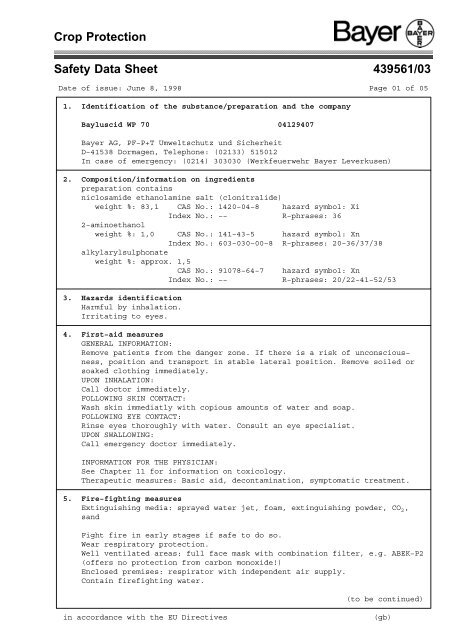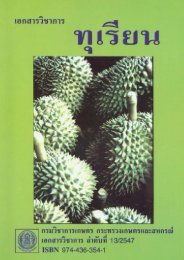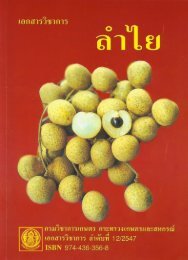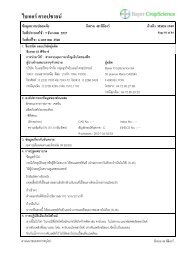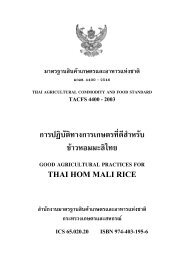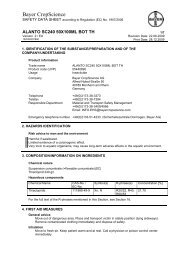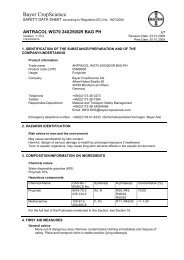Crop Protection Safety Data Sheet 439561/03 - Bayercropscience ...
Crop Protection Safety Data Sheet 439561/03 - Bayercropscience ...
Crop Protection Safety Data Sheet 439561/03 - Bayercropscience ...
Create successful ePaper yourself
Turn your PDF publications into a flip-book with our unique Google optimized e-Paper software.
<strong>Crop</strong> <strong>Protection</strong><br />
<strong>Safety</strong> <strong>Data</strong> <strong>Sheet</strong> <strong>439561</strong>/<strong>03</strong><br />
Date of issue: June 8, 1998 Page 01 of 05<br />
1. Identification of the substance/preparation and the company<br />
Bayluscid WP 70 04129407<br />
Bayer AG, PF−P+T Umweltschutz und Sicherheit<br />
D−41538 Dormagen, Telephone: (02133) 515012<br />
In case of emergency: (0214) 3<strong>03</strong><strong>03</strong>0 (Werkfeuerwehr Bayer Leverkusen)<br />
2. Composition/information on ingredients<br />
preparation contains<br />
niclosamide ethanolamine salt (clonitralide)<br />
weight %: 83,1 CAS No.: 1420−04−8 hazard symbol: Xi<br />
Index No.: −− R−phrases: 36<br />
2−aminoethanol<br />
weight %: 1,0 CAS No.: 141−43−5 hazard symbol: Xn<br />
Index No.: 6<strong>03</strong>−<strong>03</strong>0−00−8<br />
alkylarylsulphonate<br />
weight %: approx. 1,5<br />
CAS No.: 91078−64−7<br />
Index No.: −−<br />
3. Hazards identification<br />
Harmful by inhalation.<br />
Irritating to eyes.<br />
R−phrases: 20−36/37/38<br />
hazard symbol: Xn<br />
R−phrases: 20/22−41−52/53<br />
4. First−aid measures<br />
GENERAL INFORMATION:<br />
Remove patients from the danger zone. If there is a risk of unconscious−<br />
ness, position and transport in stable lateral position. Remove soiled or<br />
soaked clothing immediately.<br />
UPON INHALATION:<br />
Call doctor immediately.<br />
FOLLOWING SKIN CONTACT:<br />
Wash skin immediatly with copious amounts of water and soap.<br />
FOLLOWING EYE CONTACT:<br />
Rinse eyes thoroughly with water. Consult an eye specialist.<br />
UPON SWALLOWING:<br />
Call emergency doctor immediately.<br />
INFORMATION FOR THE PHYSICIAN:<br />
See Chapter 11 for information on toxicology.<br />
Therapeutic measures: Basic aid, decontamination, symptomatic treatment.<br />
5. Fire−fighting measures<br />
Extinguishing media: sprayed water jet, foam, extinguishing powder, CO 2 ,<br />
sand<br />
Fight fire in early stages if safe to do so.<br />
Wear respiratory protection.<br />
Well ventilated areas: full face mask with combination filter, e.g. ABEK−P2<br />
(offers no protection from carbon monoxide!)<br />
Enclosed premises: respirator with independent air supply.<br />
Contain firefighting water.<br />
(to be continued)<br />
in accordance with the EU Directives<br />
(gb)
<strong>Crop</strong> <strong>Protection</strong><br />
<strong>Safety</strong> <strong>Data</strong> <strong>Sheet</strong> <strong>439561</strong>/<strong>03</strong><br />
Date of issue: June 8, 1998 Page 02 of 05<br />
Bayluscid WP 70 04129407<br />
5. Fire−fighting measures (Continuation)<br />
In the event of fire, the formation of hydrogen chloride, hydrogen cyanide,<br />
carbon monoxide and nitrogen oxides must be anticipated.<br />
6. Accidental release measures<br />
Use the personal protective equipment listed in Chapter 8. Do not empty<br />
into drains or waters. Take up spilled product with dust−binding material<br />
or suitable vacuum cleaner. Avoid formation of dust. Fill materials taken<br />
up into closable container. To clean the floor and all objects contaminated<br />
by this material, use damp cloth. Also place used cleaning materials into<br />
closable receptacles.<br />
7. Handling and storage<br />
INFORMATION ON SAFE HANDLING:<br />
Suitable container materials: LDPE (low density polyethylene).<br />
When using open containers, use local exhaust ventilation to prevent dusts<br />
from spreading. Make provision for product and fire−fighting water to be<br />
retained.<br />
INFORMATION ON FIRE AND EXPLOSION PREVENTION:<br />
Take precautions to prevent formation of explosive mixtures:<br />
Keep away from sources of ignition − No smoking.<br />
Follow the explosion protection guidelines of the "Berufsgenossenschaft der<br />
Chemischen Industrie" (Employers’ Liability Insurance Association for the<br />
German Chemical Industry).<br />
Keep container tightly closed.<br />
Prevent formation of dust deposits and whirling−up of dust.<br />
INFORMATION ON STORAGE:<br />
See Chapter 15 for storage regulations.<br />
Observe the rules contained in the VCI concept for separate/common storage.<br />
For reasons of quality assurance, keep dry at temperatures under 40 °C.<br />
Store so that unauthorised persons do not have access. Keep away from food,<br />
drink and animal feeding stuffs.<br />
8. Exposure controls/Personal protection<br />
For technical protective measures to limit exposure see also Chapter 7<br />
"Handling and storage".<br />
Workplace−related thresholds are listed in Chapter 15 "Regulations".<br />
If product is handled while not enclosed, and if skin contact may occur:<br />
Respiratory protection: Fine dust mask (Class P1)<br />
Respiratory protection instructions ZH1/701 issued by the German<br />
Confederation of Commercial Employers’ Accident Liability Insurance<br />
Associations must be observed.<br />
Hand protection: protective gloves for chemicals<br />
Eye protection: goggles<br />
Occupational health:<br />
Keep the place of work clean. Avoid contact with product. Keep working<br />
clothes separate. Change badly soiled or soaked clothing. Wash hands before<br />
breaks and at end of work.<br />
in accordance with the EU Directives<br />
(gb)
<strong>Crop</strong> <strong>Protection</strong><br />
<strong>Safety</strong> <strong>Data</strong> <strong>Sheet</strong> <strong>439561</strong>/<strong>03</strong><br />
Date of issue: June 8, 1998 Page <strong>03</strong> of 05<br />
Bayluscid WP 70 04129407<br />
9. Physical and chemical properties tested in accordance with<br />
Form:<br />
solid, powder<br />
Colour:<br />
yellow to orange<br />
Odour:<br />
slight characteristic smell<br />
pH value:<br />
9,0−10,0 at 0,5 % in water<br />
Melting point: approx. 165 °C<br />
Bulk volume fluffed: approx. 280 ml/100 g<br />
Bulk volume jolted: approx. 210 ml/100 g<br />
Solubility in water: dispersible<br />
Partition coefficient: log P octanol/water =<br />
niclosamide ethanolamine salt<br />
(clonitralide): 0,99<br />
Solid products combustibility: BZ 3 = local burning or glowing with, at the<br />
most, only slight spreading (VDI 2263).<br />
Risk of dust explosion: may cause dust explosion<br />
Impact sensitivity:<br />
not impact sensitive<br />
10. Stability and reactivity<br />
11. Toxicological information<br />
Acute toxicity:<br />
LD 50 oral, rat (male): 3552 mg/kg (Bayer) (1)<br />
LD 50 dermal, rat: > 4000 mg/kg (Bayer) (1)<br />
LC 50 inhalation, rat (male): 3,6−8,2 mg/l, Dustable powder, 4 h of exposure<br />
(Bayer) (1)<br />
Irritation of the skin/rabbit: slightly irritant * (Bayer) (1)<br />
Irritant to the mucous membranes/rabbit: moderately irritant (Bayer) (1)<br />
* does not necessitate labelling<br />
(1) Test results of a similar product<br />
12. Ecological information<br />
Fish toxicity: (active ingredient):<br />
LC 50 : 0,05 ppm (48 h); rainbow trout (Salmo gairdneri) (Bayer)<br />
LC 50 : 0,082 ppm (48 h); (Lepomis macrochirus) (Bayer)<br />
LC 50 : 0,279 ppm (48 h); goldfish (Carassius auratus) (Bayer)<br />
LC 50 : 0,235 ppm (48 h); carp (Cyprinus carpio) (Bayer)<br />
13. Disposal considerations<br />
In cases where larger amounts of the product have become unusable, it<br />
should be established whether material utilisation is possible (if<br />
necessary, consult the manufacturer/suppliers). Small amounts of the<br />
product and uncleaned empty packaging should be packaged and sealed,<br />
labelled and transferred to a suitable incinerator in accordance with the<br />
local regulations.<br />
531<strong>03</strong> Old stock and remainders of crop protection and pest control products<br />
53104 Production waste from crop protection and pest control products<br />
*14. Transport information<br />
GGVSee/IMDG Code: −− UN No.: no MFAG: −− EmS: −−<br />
PG: −− MPO: −−<br />
(to be continued)<br />
in accordance with the EU Directives<br />
(gb)
<strong>Crop</strong> <strong>Protection</strong><br />
<strong>Safety</strong> <strong>Data</strong> <strong>Sheet</strong> <strong>439561</strong>/<strong>03</strong><br />
Date of issue: June 8, 1998 Page 04 of 05<br />
Bayluscid WP 70 04129407<br />
*14. Transport information (Continuation)<br />
GGVE/GGVS: Class 9 No. 12C RID/ADR: Class 9 No. 12C<br />
Warning sign: Hazard no. 090 Substance no. 3077<br />
ADNR: Class 9 No. 12C Cat −− ICAO/IATA−DGR: 9 3077 III<br />
Limited quantity regulation applicable in accordance with a−marginal−<br />
number GGVE/RID/GGVS/ADR/ADNR in compliance with threshold value<br />
Declaration for land shipment:<br />
3077, Umweltgefaehrdender Stoff, fest,<br />
n.a.g.<br />
(83% NICLOSAMID ETHANOLAMINSALZ(PULVER))<br />
Declaration for sea shipment:<br />
Declaration for shipment by air: Environmentally hazardous substance, so−<br />
lid, n.o.s.<br />
(83% NICLOSAMIDE ETHANOLAMINE<br />
SALT (POWDER))<br />
Other information:<br />
Environmentally hazardous substance (GGVE/GGVS, RID/ADR). Irritating to the<br />
eyes. Slightly smelling. Keep dry. Avoid heat above +40 °C. Keep separated<br />
from foodstuffs.<br />
Further information can be found in section 16.<br />
*15. Regulatory information<br />
Labelling in accordance with directive 88/379/EEC (preparations) and its<br />
amendments and adaptations:<br />
Symbol: Xn, hazard description: harmful<br />
Contains: 83,1 % niclosamide ethanolamine salt (clonitralide)<br />
R 20: Harmful by inhalation.<br />
R 36: Irritating to eyes.<br />
This labelling is not required for products in packages intended for end<br />
users.<br />
Threshold value in air defined by TRGS 900 (MAK value):<br />
General limiting value of dust − 6 mg fine dust per m³ air.<br />
2−aminoethanol:<br />
German Technical Guideline Air (TA−Luft) (3.1.7.): Class I<br />
Major incidents regulations of September 20, 1991:<br />
The preparation is a "pesticide/agrochemical or active ingredient thereof"<br />
in accordance with Appendix III, Part 1 No.21.<br />
VCI storage class: 11<br />
Note the following Guidelines and Directives of the Employers Liability<br />
Accident Insurance (BG Chemie):<br />
M 004 "Reizende Stoffe − Ätzende Stoffe" (irritant − caustic substances)<br />
M 050 "Umgang mit gesundheitsgefährlichen Stoffen" (regulations on the<br />
handling of substances hazardous to health)<br />
M 053 "Allgemeine Arbeitsschutzmaßnahmen für den Umgang mit Gefahrstoffen"<br />
(general work safety measures for the handling of dangerous materials)<br />
All the constituents are classified as existing chemicals in the EC Guide−<br />
lines.<br />
in accordance with the EU Directives<br />
(gb)
<strong>Crop</strong> <strong>Protection</strong><br />
<strong>Safety</strong> <strong>Data</strong> <strong>Sheet</strong> <strong>439561</strong>/<strong>03</strong><br />
Date of issue: June 8, 1998 Page 05 of 05<br />
Bayluscid WP 70 04129407<br />
16. Other information<br />
Wettable powder<br />
Application: molluscicide<br />
Note on Chapter 14:<br />
The Declaration for land shipment is reproduced in German and applies in<br />
Europe and some of its adjoining states. It has been translated into<br />
English as follows:<br />
3077, Environmentally hazardous substance, solid, n.o.s.<br />
(83% NICLOSAMIDE ETHANOLAMINE SALT (POWDER))<br />
Address in case of poisoning, Bayer AG; Feuerwehr<br />
fire or damage: D−41538 Dormagen; Tel. 02133/514233<br />
The data given here is based on current knowledge and experience. The purpose<br />
of this <strong>Safety</strong> <strong>Data</strong> <strong>Sheet</strong> is to describe the products in terms of their safety<br />
requirements. The data does not signify any warranty with regard to the<br />
products’ properties.


